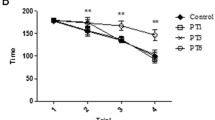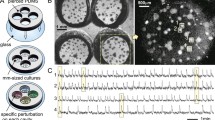Abstract
In recent decades, considerable efforts have been made to understand the mechanism of memory, cognition, and relevant neurodegenerative diseases in the human brain. Several studies have shown the importance of microtubule proteins in the memory mechanism and memory dysfunction. Microtubules possess dynamicity, which is essential for functions of neuronal networks. Microtubule-associated proteins, i.e., tau, play vital roles in microtubule stability. On the other hand, the ferromagnetic mineral magnetite (Fe3O4) has been detected in the normal human brain, and elevated levels of magnetite are also observed in the brains of Alzheimer’s disease patients. Therefore, we propose that a relationship between microtubule organization in axons and brain magnetite nanoparticles is possible. In this study we found alterations of microtubule polymerization in the presence of increasing concentrations of magnetite through transmission electron microscopy images and a turbidimetry method. Structural changes of microtubule and tau protein, as an essential microtubule-associated protein for tubulin assembly, were detected via circular dichroism spectroscopy, intrinsic fluorescence, and 8-anilino-1-naphthalenesulfonic acid fluorometry. We predicted three possible binding sites on tau protein and one possible binding site on tubulin dimer for magnetite nanoparticles. Magnetite also causes the morphology of PC12 cells to change abnormally and cell viability to decrease. Finally, we suggest that magnetite changes microtubule dynamics and polymerization through two paths: (1) changing the secondary and tertiary structure of tubulin and (2) binding to either tubulin dimer or tau protein and preventing tau–tubulin interaction.











Similar content being viewed by others
References
Hameroff SR, Watt RC (1982) Information processing in microtubules. J Theor Biol 98:549–561
Faber J, Portugal R, Rosa LP (2006) Information processing in brain microtubules. Biosystems 83:1–9
Tuszyński JA, Hameroff S, Satarić MV, Trpisová B, Nip MLA (1995) Ferroelectric behavior in microtubule dipole lattices: implications for information processing, signaling and assembly/disassembly. J Theor Biol 174:371–380
Minoura I, Muto E (2006) Dielectric measurement of individual microtubules using the electroorientation method. Biophys J 90:3739–3748
Nogales E (2000) Structural insights into microtubule function. Annu Rev Biochem 69:277–302
Tuszynski JA, Brown JA, Crawford E, Carpenter EJ (2005) Molecular dynamics simulations of tubulin structure and calculations of electrostatic properties of microtubules. Math Comput Model 41:1055–1070
Ballatore C, Brunden KR, Huryn DM, Trojanowski JQ, Lee VM, Smith AB 3rd (2012) Microtubule stabilizing agents as potential treatment for Alzheimer’s disease and related neurodegenerative tauopathies. J Med Chem 55:8979–8996
Iqbal K, Grundke-Iqbal I, Zaidi T, Merz PA, Wen GY, Shaikh SS, Wisniewski HM, Alafuzoff I, Winblad B (1986) Defective brain microtubule assembly in Alzheimer’s disease. Lancet 2:421–426
Shevtsov PN, Shevtsova EF, Burbaeva G, Bachurin SO (2006) Disturbed assembly of human cerebral microtubules in Alzheimer’s disease. Bull Exp Biol Med 141:265–268
Cash AD, Aliev G, Siedlak SL, Nunomura A, Fujioka H, Zhu X, Raina AK, Vinters HV, Tabaton M, Johnson AB, Paula-Barbosa M, Avila J, Jones PK, Castellani RJ, Smith MA, Perry G (2003) Microtubule reduction in Alzheimer’s disease and aging is independent of tau filament formation. Am J Pathol 162:1623–1627
Lee G, Leugers CJ (2012) Tau and tauopathies. Prog Mol Biol Transl Sci 107:263–293
Kirschvink JL, Kobayashi-Kirschvink A, Woodford BJ (1992) Magnetite biomineralization in the human brain. Proc Natl Acad Sci USA 89:7683–7687
Kirschvink JL, Kobayashi-Kirschvink A, Diaz-Ricci JC, Kirschvink SJ (1992) Magnetite in human tissues: a mechanism for the biological effects of weak ELF magnetic fields. Bioelectromagnetics Suppl 1:101–113
Schultheiss-Grassi PP, Wessiken R, Dobson J (1999) TEM investigations of biogenic magnetite extracted from the human hippocampus. Biochim Biophys Acta 1426:212–216
Dobson J (2001) Nanoscale biogenic iron oxides and neurodegenerative disease. FEBS Lett 496:1–5
Gossuin Y, Hautot D, Muller RN, Pankhurst Q, Dobson J, Morris C, Gillis P, Collingwood J (2005) Looking for biogenic magnetite in brain ferritin using NMR relaxometry. NMR Biomed 18:469–472
Collingwood JF, Mikhaylova A, Davidson M, Batich C, Streit WJ, Terry J, Dobson J (2005) In situ characterization and mapping of iron compounds in Alzheimer’s disease tissue. J Alzheimers Dis 7:267–272
Quintana C, Bellefqih S, Laval JY, Guerquin-Kern JL, Wu TD, Avila J, Ferrer I, Arranz R, Patino C (2006) Study of the localization of iron, ferritin, and hemosiderin in Alzheimer’s disease hippocampus by analytical microscopy at the subcellular level. J Struct Biol 153:42–54
Haacke EM, Cheng NY, House MJ, Liu Q, Neelavalli J, Ogg RJ, Khan A, Ayaz M, Kirsch W, Obenaus A (2005) Imaging iron stores in the brain using magnetic resonance imaging. Magn Reson Imaging 23:1–25
Dobson J (2004) Magnetic iron compounds in neurological disorders. Ann N Y Acad Sci 1012:183–192
Banaclocha MA, Bokkon I, Banaclocha HM (2010) Long-term memory in brain magnetite. Med Hypotheses 74:254–257
Hautot D, Pankhurst QA, Khan N, Dobson J (2003) Preliminary evaluation of nanoscale biogenic magnetite in Alzheimer’s disease brain tissue. Proc Biol Sci 270(Suppl 1):S62–S64
Hautot D, Pankhurst QA, Morris CM, Curtis A, Burn J, Dobson J (2007) Preliminary observation of elevated levels of nanocrystalline iron oxide in the basal ganglia of neuroferritinopathy patients. Biochim Biophys Acta 1772:21–25
Stracke R, Bohm KJ, Wollweber L, Tuszynski JA, Unger E (2002) Analysis of the migration behaviour of single microtubules in electric fields. Biochem Biophys Res Commun 293:602–609
Havelka D, Cifra M (2009) Calculation of the electromagnetic field around a microtubule. Acta Polytech 49:58–63
Pokorny J (2004) Excitation of vibrations in microtubules in living cells. Bioelectrochemistry 63:321–326
Hui C, Shen C, Yang T, Bao L, Tian J, Ding H, Li C, Gao H-J (2008) Large-scale Fe3O4 nanoparticles soluble in water synthesized by a facile method. J Phys Chem C 112:11336–11339
Wu W, He Q, Jiang C (2008) Magnetic iron oxide nanoparticles: synthesis and surface functionalization strategies. Nanoscale Res Lett 3:397–415
Miller HP, Wilson L (2010) Preparation of microtubule protein and purified tubulin from bovine brain by cycles of assembly and disassembly and phosphocellulose chromatography. Methods Cell Biol 95:3–15
Williams RC Jr, Lee JC (1982) Preparation of tubulin from brain. Methods Enzymol 85:376–385
Furukawa Y, Kaneko K, Nukina N (2011) Tau protein assembles into isoform- and disulfide-dependent polymorphic fibrils with distinct structural properties. J Biol Chem 286:27236–27246
Gaskin F, Cantor CR, Shelanski ML (1974) Turbidimetric studies of the in vitro assembly and disassembly of porcine neurotubules. J Mol Biol 89:737–755
Chang GG, Lee HJ (1984) Monitoring protein conformational changes by quenching of intrinsic fluorescence. J Biochem Biophys Methods 9:351–355
Kamen DE, Woody RW (2001) A partially folded intermediate conformation is induced in pectate lyase C by the addition of 8-anilino-1-naphthalenesulfonate (ANS). Protein Sci 10:2123–2130
Greene LA, Tischler AS (1976) Establishment of a noradrenergic clonal line of rat adrenal pheochromocytoma cells which respond to nerve growth factor. Proc Natl Acad Sci USA 73:2424–2428
Scudiero DA, Shoemaker RH, Paull KD, Monks A, Tierney S, Nofziger TH, Currens MJ, Seniff D, Boyd MR (1988) Evaluation of a soluble tetrazolium/formazan assay for cell growth and drug sensitivity in culture using human and other tumor cell lines. Cancer Res 48:4827–4833
Deng F, Liu Y (2012) Study of the interaction between tosufloxacin tosylate and bovine serum albumin by multi-spectroscopic methods. J Lumin 132:443–448
Ding J, Yuan L, Gao L, Chen J (2012) Fluorescence quenching of a rhodamine derivative: selectively sensing Cu2+ in acidic aqueous media. J Lumin 132:1987–1993
Faridbod F, Ganjali MR, Larijani B, Riahi S, Saboury AA, Hosseini M, Norouzi P, Pillip C (2011) Interaction study of pioglitazone with albumin by fluorescence spectroscopy and molecular docking. Spectrochim Acta A Mol Biomol Spectrosc 78:96–101
Jayabharathi J, Thanikachalam V, Srinivasan N, Perumal MV (2011) Luminescent study on the binding interaction of bioactive imidazole with bovine serum albumin-a static quenching mechanism. Spectrochim Acta A Mol Biomol Spectrosc 84:233–237
Zhang MF, Xu ZQ, Ge YS, Jiang FL, Liu Y (2012) Binding of fullerol to human serum albumin: spectroscopic and electrochemical approach. J Photochem Photobiol B 108:34–43
Tabassum S, Al-Asbahy WM, Afzal M, Arjmand F (2012) Synthesis, characterization and interaction studies of copper based drug with Human Serum Albumin (HSA): spectroscopic and molecular docking investigations. J Photochem Photobiol B 114:132–139
Yue Y, Chen X, Qin J, Yao X (2009) Spectroscopic investigation on the binding of antineoplastic drug oxaliplatin to human serum albumin and molecular modeling. Colloids Surf B Biointerfaces 69:51–57
Bhattacharyya B, Wolff J (1974) Promotion of fluorescence upon binding of colchicine to tubulin. Proc Natl Acad Sci USA 71:2627–2631
Jansen B, Nierop KG, Vrugt JA, Verstraten JM (2004) (Un)certainty of overall binding constants of Al with dissolved organic matter determined by the Scatchard approach. Water Res 38:1270–1280
Mayawala K, Vlachos DG, Edwards JS (2005) Heterogeneities in EGF receptor density at the cell surface can lead to concave up scatchard plot of EGF binding. FEBS Lett 579:3043–3047
Divsalar A, Saboury AA, Moosavi-Movahedi AA (2006) Conformational and structural analysis of bovine beta lactoglobulin-A upon interaction with Cr+3. Protein J 25:157–165
Sun Y, Wei S, Yin C, Liu L, Hu C, Zhao Y, Ye Y, Hu X, Fan J (2011) Synthesis and spectroscopic characterization of 4-butoxyethoxy-N-octadecyl-1,8-naphthalimide as a new fluorescent probe for the determination of proteins. Bioorg Med Chem Lett 21:3798–3804
Liang L, Subirade M (2010) Beta-lactoglobulin/folic acid complexes: formation, characterization, and biological implication. J Phys Chem B 114:6707–6712
Sengupta B, Sengupta PK (2002) The interaction of quercetin with human serum albumin: a fluorescence spectroscopic study. Biochem Biophys Res Commun 299:400–403
Hu YJ, Yue HL, Li XL, Zhang SS, Tang E, Zhang LP (2012) Molecular spectroscopic studies on the interaction of morin with bovine serum albumin. J Photochem Photobiol B 112:16–22
Shamos MH, Lavine LS (1967) Piezoelectricity as a fundamental property of biological tissues. Nature 213:267–269
Fukada E (1995) Piezoelectricity of biopolymers. Biorheology 32:593–609
Athenstaedt H (1974) Pyroelectric and piezoelectric properties of vertebrates. Ann N Y Acad Sci 238:68–94
Brown JA, Tuszynski JA (1999) A review of the ferroelectric model of microtubules. Ferroelectrics 220:141–155
Ruiz-Canada C, Ashley J, Moeckel-Cole S, Drier E, Yin J, Budnik V (2004) New synaptic bouton formation is disrupted by misregulation of microtubule stability in aPKC mutants. Neuron 42:567–580
Bunker JM, Kamath K, Wilson L, Jordan MA, Feinstein SC (2006) FTDP-17 mutations compromise the ability of tau to regulate microtubule dynamics in cells. J Biol Chem 281:11856–11863
Schoutens JE (2005) Dipole–dipole interactions in microtubules. J Biol Phys 31:35–55
Craddock TJ, Tuszynski JA, Chopra D, Casey N, Goldstein LE, Hameroff SR, Tanzi RE (2012) The zinc dyshomeostasis hypothesis of Alzheimer’s disease. PLoS One 7:e33552
Acknowledgments
This research was supported by the Neuroorganic Laboratory at the Institute of Biochemistry and Biophysics, University of Tehran. We are grateful to Maryam Aghamiari, Darian Fard, and Soheil Afsharpour for their help in purifying microtubules and preparing the manuscript.
Author information
Authors and Affiliations
Corresponding author
Rights and permissions
About this article
Cite this article
Dadras, A., Riazi, G.H., Afrasiabi, A. et al. In vitro study on the alterations of brain tubulin structure and assembly affected by magnetite nanoparticles. J Biol Inorg Chem 18, 357–369 (2013). https://doi.org/10.1007/s00775-013-0980-x
Received:
Accepted:
Published:
Issue Date:
DOI: https://doi.org/10.1007/s00775-013-0980-x




